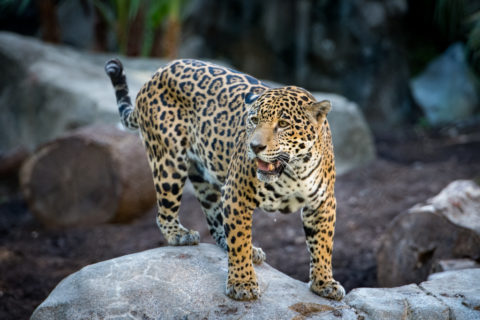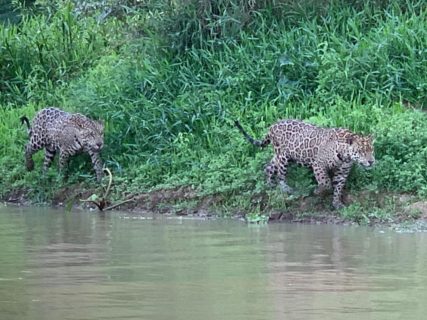Good News: We’re Protecting Jaguars in the Wild
 Earlier today, you saw our female jaguar, Maya, jump 9 feet the air for her bone-in meat enrichment, which encourages natural gorging, exercise, and failure behaviors they would face in the wild.
Earlier today, you saw our female jaguar, Maya, jump 9 feet the air for her bone-in meat enrichment, which encourages natural gorging, exercise, and failure behaviors they would face in the wild.
Jaguars are an elusive predator and are found in varying habitats, sometimes overlapping with people. They are involved in a lot of conflict with ranchers across their range and are often blamed for killing livestock with retaliation often involving the death of a jaguar. Due to this perception, hunting and habitat loss jaguar populations have decreased, but tourism is revealing that jaguars are a real value to the country.
In Porto Jofre, tourism and the dollars it brings are protecting jaguars, giant otters, and every other species that live in this region. People come from all over the world to view wildlife here. If you want to see a jaguar, this is the place to come to! There are 120 known individual jaguars along these rivers and their tributaries. That is an extremely high density for a top predator but to support the jaguars there is also a high density of capybara (the world’s largest living rodent) and caiman. Jaguars in this part of the Pantanal are caiman specialists as they grab them on the banks or dive into the rivers after them. Jaguars are one of the few cats comfortable in water and are also good swimmers.

The Zoo is working with conservation partners to train local guides in Brazil to have giant otter and jaguar safe practices. These trainings ensure guides understand the various species behaviors and maintain appropriate distances that won’t interfere their normal behaviors and will allow for the animal to thrive.
By supporting our Emergency Zoo Fund, you help ensure that we fulfill our mission of connecting communities with animals and inspiring action to save wildlife, even during these challenging times.
